1997 SSANGYONG KORANDO section 2c
[x] Cancel search: section 2cPage 1502 of 2053
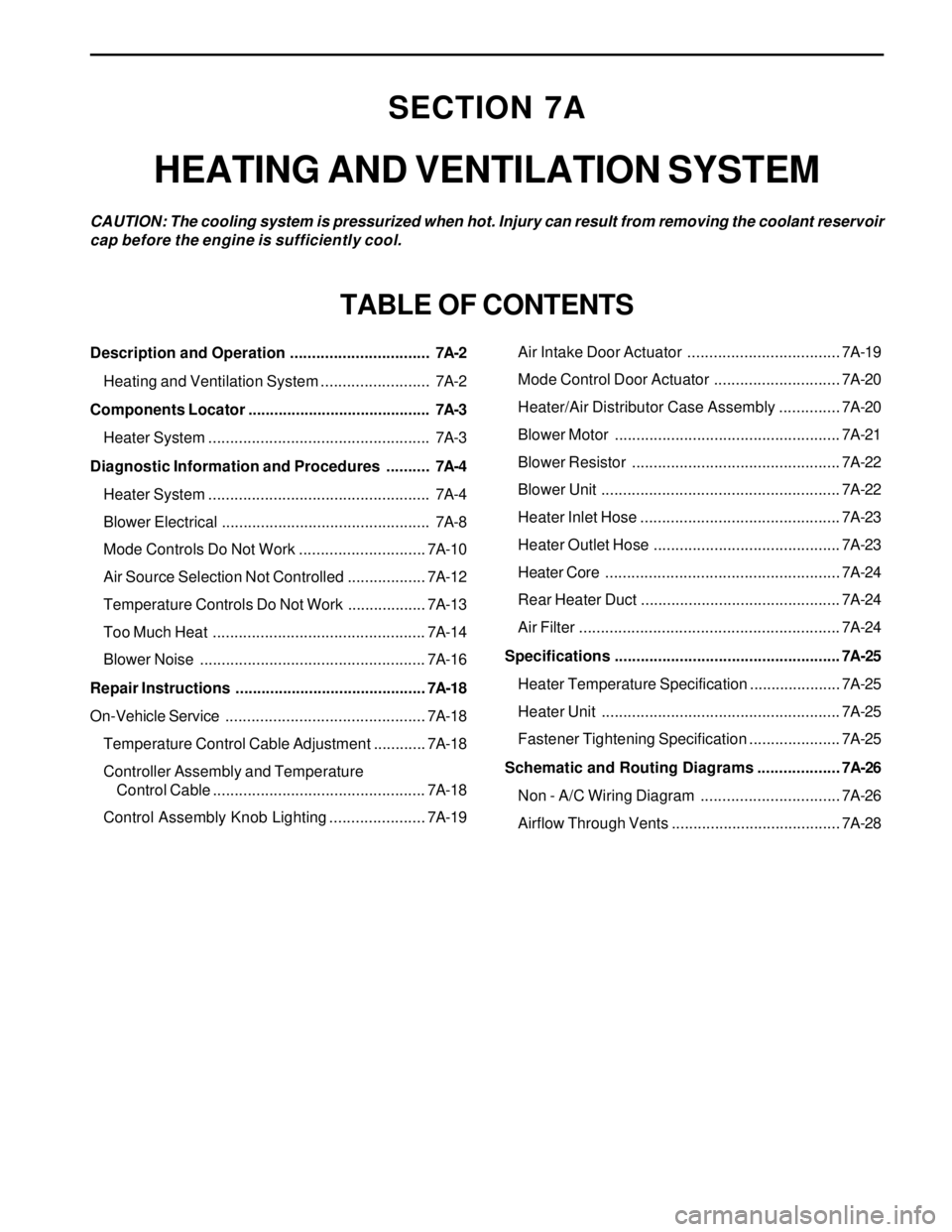
SECTION 7A
HEATING AND VENTILATION SYSTEM
CAUTION: The cooling system is pressurized when hot. Injury can result from removing the coolant reservoir
cap before the engine is sufficiently cool.
TABLE OF CONTENTS
Description and Operation ................................7A-2
Heating and Ventilation System .........................7A-2
Components Locator ..........................................7A-3
Heater System ...................................................7A-3
Diagnostic Information and Procedures ..........7A-4
Heater System ...................................................7A-4
Blower Electrical ................................................7A-8
Mode Controls Do Not Work .............................7A-10
Air Source Selection Not Controlled ..................7A-12
Temperature Controls Do Not Work ..................7A-13
Too Much Heat .................................................7A-14
Blower Noise ....................................................7A-16
Repair Instructions ............................................7A-18
On-Vehicle Service..............................................7A-18
Temperature Control Cable Adjustment ............7A-18
Controller Assembly and Temperature
Control Cable .................................................7A-18
Control Assembly Knob Lighting ......................7A-19Air Intake Door Actuator ...................................7A-19
Mode Control Door Actuator .............................7A-20
Heater/Air Distributor Case Assembly ..............7A-20
Blower Motor ....................................................7A-21
Blower Resistor ................................................7A-22
Blower Unit .......................................................7A-22
Heater Inlet Hose ..............................................7A-23
Heater Outlet Hose ...........................................7A-23
Heater Core......................................................7A-24
Rear Heater Duct ..............................................7A-24
Air Filter ............................................................7A-24
Specifications .................................................... 7A-25
Heater Temperature Specification .....................7A-25
Heater Unit .......................................................7A-25
Fastener Tightening Specification .....................7A-25
Schematic and Routing Diagrams ................... 7A-26
Non - A/C Wiring Diagram ................................7A-26
Airflow Through Vents .......................................7A-28
Page 1505 of 2053
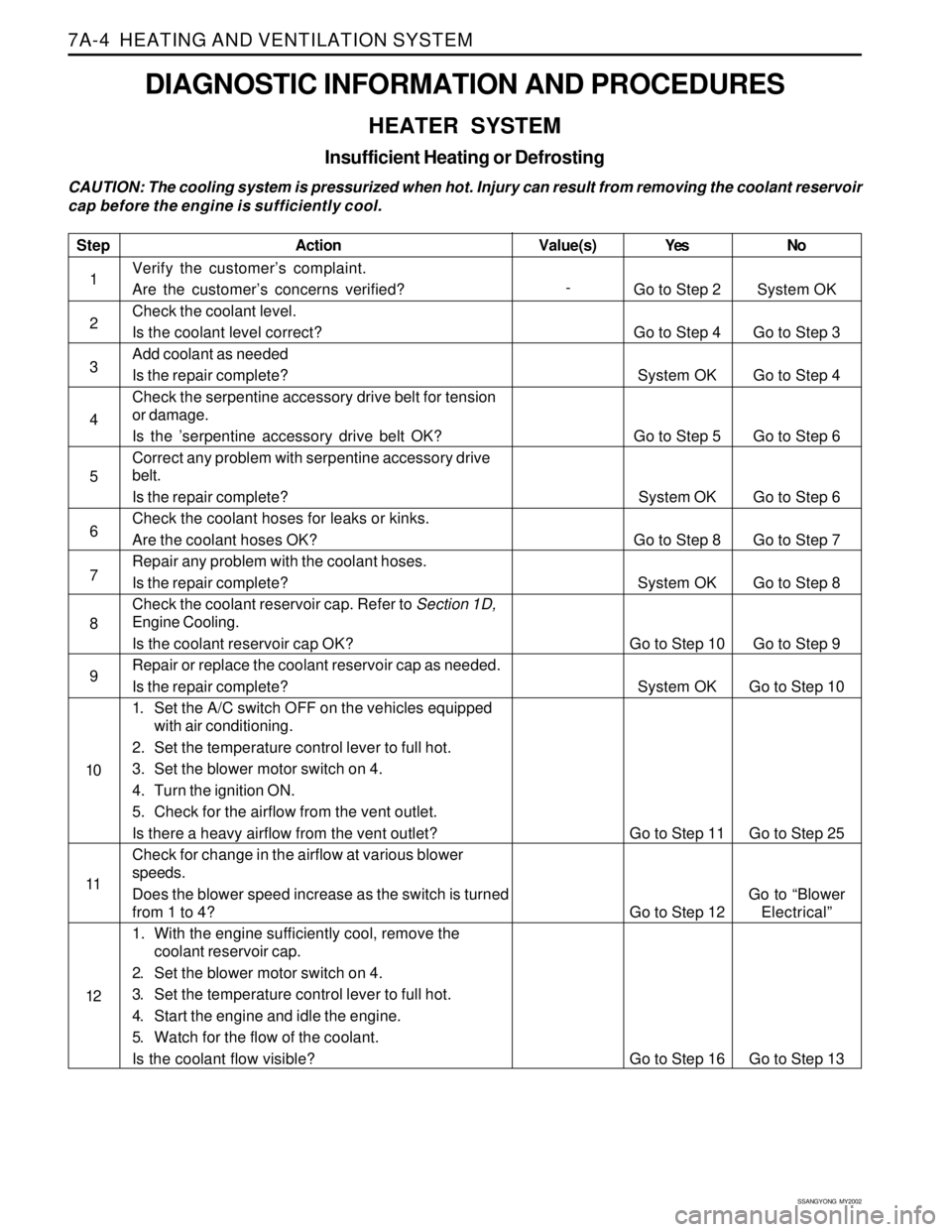
SSANGYONG MY2002
7A-4 HEATING AND VENTILATION SYSTEM
DIAGNOSTIC INFORMATION AND PROCEDURES
HEATER SYSTEM
Insufficient Heating or Defrosting
CAUTION: The cooling system is pressurized when hot. Injury can result from removing the coolant reservoir
cap before the engine is sufficiently cool.
Step
1
2
3
4
5
6
7
8
9
10
11
12
Action
Verify the customer’s complaint.
Are the customer’s concerns verified?
Check the coolant level.
Is the coolant level correct?
Add coolant as needed
Is the repair complete?
Check the serpentine accessory drive belt for tension
or damage.
Is the ’serpentine accessory drive belt OK?
Correct any problem with serpentine accessory drive
belt.
Is the repair complete?
Check the coolant hoses for leaks or kinks.
Are the coolant hoses OK?
Repair any problem with the coolant hoses.
Is the repair complete?
Check the coolant reservoir cap. Refer to Section 1D,
Engine Cooling.
Is the coolant reservoir cap OK?
Repair or replace the coolant reservoir cap as needed.
Is the repair complete?
1. Set the A/C switch OFF on the vehicles equipped
with air conditioning.
2. Set the temperature control lever to full hot.
3. Set the blower motor switch on 4.
4. Turn the ignition ON.
5. Check for the airflow from the vent outlet.
Is there a heavy airflow from the vent outlet?
Check for change in the airflow at various blower
speeds.
Does the blower speed increase as the switch is turned
from 1 to 4?
1. With the engine sufficiently cool, remove the
coolant reservoir cap.
2. Set the blower motor switch on 4.
3. Set the temperature control lever to full hot.
4. Start the engine and idle the engine.
5. Watch for the flow of the coolant.
Is the coolant flow visible?Yes
Go to Step 2
Go to Step 4
System OK
Go to Step 5
System OK
Go to Step 8
System OK
Go to Step 10
System OK
Go to Step 11
Go to Step 12
Go to Step 16No
System OK
Go to Step 3
Go to Step 4
Go to Step 6
Go to Step 6
Go to Step 7
Go to Step 8
Go to Step 9
Go to Step 10
Go to Step 25
Go to “Blower
Electrical”
Go to Step 13 Value(s)
-
Page 1506 of 2053
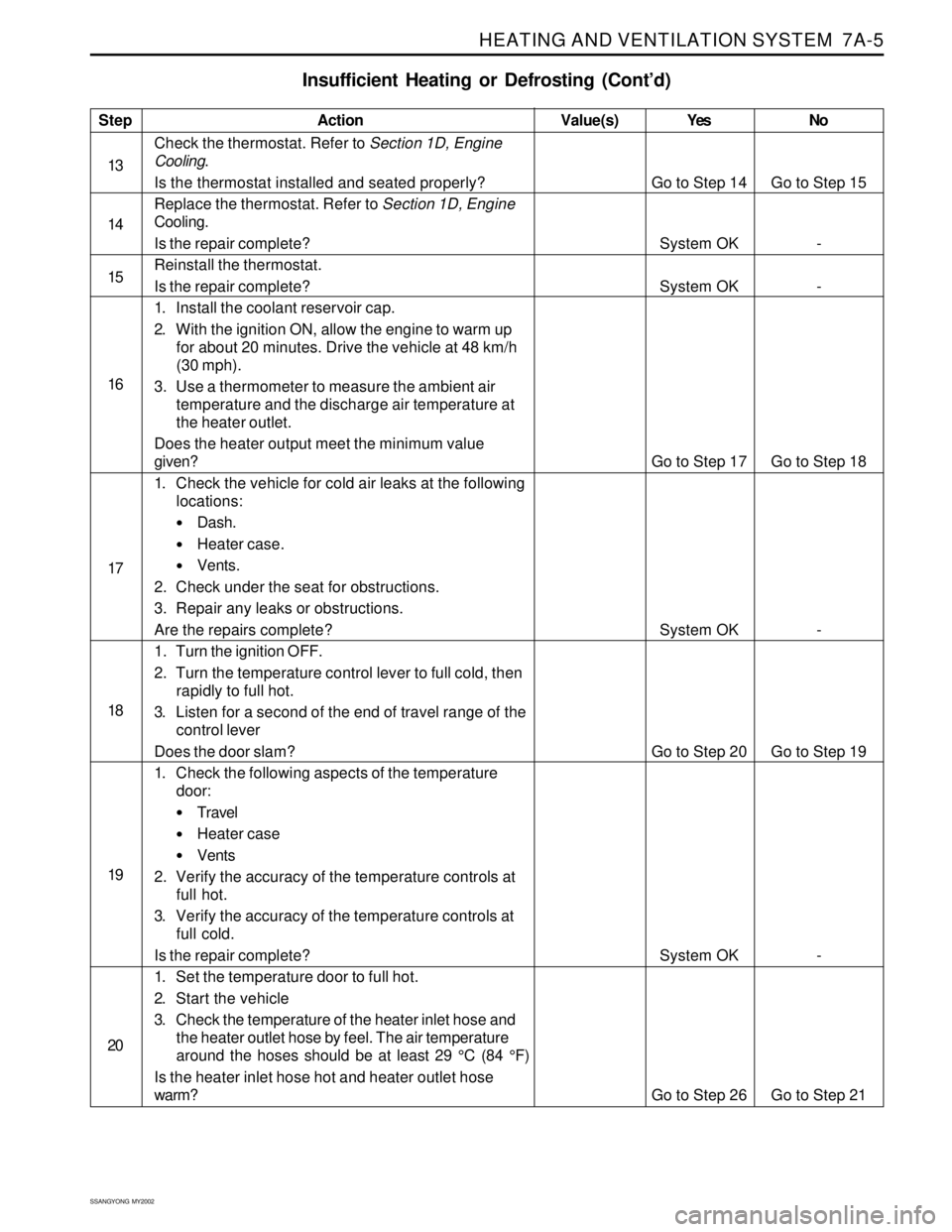
HEATING AND VENTILATION SYSTEM 7A-5
SSANGYONG MY2002
Insufficient Heating or Defrosting (Cont’d)
Step
13
14
15
16
17
18
19
20Action
Check the thermostat. Refer to Section 1D, Engine
Cooling.
Is the thermostat installed and seated properly?
Replace the thermostat. Refer to Section 1D, Engine
Cooling.
Is the repair complete?
Reinstall the thermostat.
Is the repair complete?
1. Install the coolant reservoir cap.
2. With the ignition ON, allow the engine to warm up
for about 20 minutes. Drive the vehicle at 48 km/h
(30 mph).
3. Use a thermometer to measure the ambient air
temperature and the discharge air temperature at
the heater outlet.
Does the heater output meet the minimum value
given?
1. Check the vehicle for cold air leaks at the following
locations:
Dash.
Heater case.
Vents.
2. Check under the seat for obstructions.
3. Repair any leaks or obstructions.
Are the repairs complete?
1. Turn the ignition OFF.
2. Turn the temperature control lever to full cold, then
rapidly to full hot.
3. Listen for a second of the end of travel range of the
control lever
Does the door slam?
1. Check the following aspects of the temperature
door:
Travel
Heater case
Vents
2. Verify the accuracy of the temperature controls at
full hot.
3. Verify the accuracy of the temperature controls at
full cold.
Is the repair complete?
1. Set the temperature door to full hot.
2. Start the vehicle
3. Check the temperature of the heater inlet hose and
the heater outlet hose by feel. The air temperature
around the hoses should be at least 29 °C (84 °F)
Is the heater inlet hose hot and heater outlet hose
warm?Yes
Go to Step 14
System OK
System OK
Go to Step 17
System OK
Go to Step 20
System OK
Go to Step 26No
Go to Step 15
-
-
Go to Step 18
-
Go to Step 19
-
Go to Step 21 Value(s)
Page 1507 of 2053
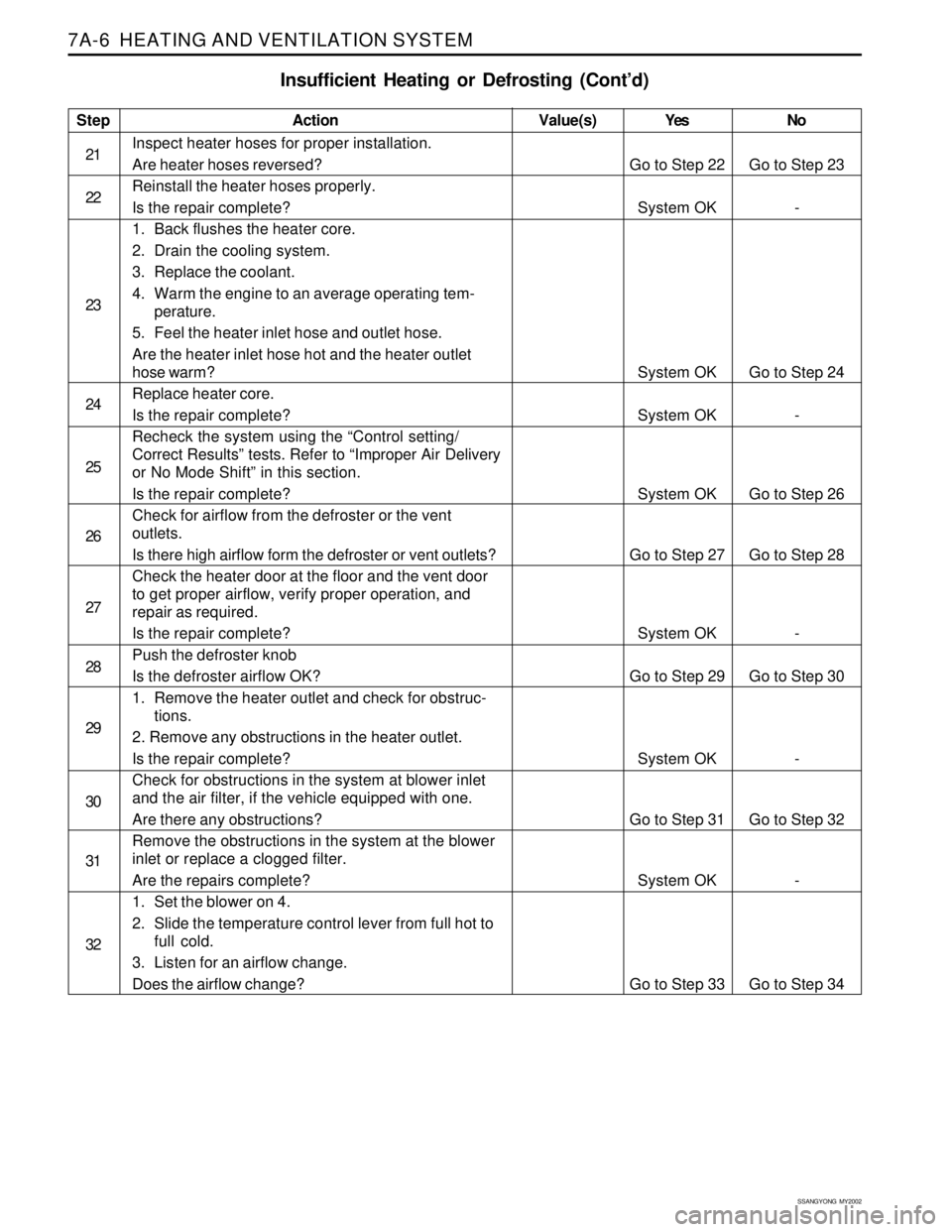
SSANGYONG MY2002
7A-6 HEATING AND VENTILATION SYSTEM
Insufficient Heating or Defrosting (Cont’d)
Step
21
22
23
24
25
26
27
28
29
30
31
32Action
Inspect heater hoses for proper installation.
Are heater hoses reversed?
Reinstall the heater hoses properly.
Is the repair complete?
1. Back flushes the heater core.
2. Drain the cooling system.
3. Replace the coolant.
4. Warm the engine to an average operating tem-
perature.
5. Feel the heater inlet hose and outlet hose.
Are the heater inlet hose hot and the heater outlet
hose warm?
Replace heater core.
Is the repair complete?
Recheck the system using the “Control setting/
Correct Results” tests. Refer to “Improper Air Delivery
or No Mode Shift” in this section.
Is the repair complete?
Check for airflow from the defroster or the vent
outlets.
Is there high airflow form the defroster or vent outlets?
Check the heater door at the floor and the vent door
to get proper airflow, verify proper operation, and
repair as required.
Is the repair complete?
Push the defroster knob
Is the defroster airflow OK?
1. Remove the heater outlet and check for obstruc-
tions.
2. Remove any obstructions in the heater outlet.
Is the repair complete?
Check for obstructions in the system at blower inlet
and the air filter, if the vehicle equipped with one.
Are there any obstructions?
Remove the obstructions in the system at the blower
inlet or replace a clogged filter.
Are the repairs complete?
1. Set the blower on 4.
2. Slide the temperature control lever from full hot to
full cold.
3. Listen for an airflow change.
Does the airflow change?Yes
Go to Step 22
System OK
System OK
System OK
System OK
Go to Step 27
System OK
Go to Step 29
System OK
Go to Step 31
System OK
Go to Step 33No
Go to Step 23
-
Go to Step 24
-
Go to Step 26
Go to Step 28
-
Go to Step 30
-
Go to Step 32
-
Go to Step 34 Value(s)
Page 1517 of 2053

SSANGYONG MY2002
7A-16 HEATING AND VENTILATION SYSTEM
BLOWER NOISE
Step
1
2
3
4
5
6
7
8
9
10
11
12
13
14Action
Verify the customer’s complaint.
Are the customer’s concerns verified?
1. Sit inside the vehicle.
2. Close the doors and windows.
3. Turn the ignition ON.
4. Start the engine.
5. Set the temperature to full cold.
6. Cycle through the blower speeds, the modes, and
the temperature settings in order to find the noise.
Is the blower noise constant at high blower speeds or
in other modes?
Check for vibrations from the blower motor and fan
assembly at each blower speed by feeling the blower
motor housing.
Did you find excessive vibration?
1. Remove the blower motor and fan assembly.
Refer to “Blower Motor” in this section.
2. Check for foreign materials at the opening of the
blower inlet.
Did you find any foreign materials at the blower inlet?
Remove all foreign materials.
Is the repair complete?
1. Examine the blower fan for wear spots, cracked
blades, a cracked hub, a loose fan retaining nuts,
or bad alignment.
2. Examine the blower case for sports.
Did you find any problem?
Repair as required.
Is the repair complete?
Replace the motor and fan assembly.
Is the repair complete?
If the noise is a click/tick or whine, replace the motor.
Is the repair complete?
Reinstall the original motor.
Is the problem still present?
1. Set the blower speed on 4.
2. Check full hot to full cold temperature positions in
the defroster, floor, and vent modes.
Is the noise present in the defrost mode only?
1. Check the ducts for obstructions for foreign
materials.
2. Remove any obstructions or foreign materials.
3. Check floor /defroster door seals.
4. Repair or replace as needed.
Is the repair complete?
Is the noise present in the floor mode only?
Is the noise present in the vent mode only?Yes
Go to Step 2
Go to Step 11
Go to Step 6
Go to Step 5
System OK
Go to Step 7
System OK
System OK
System OK
Go to Step 11
Go to Step 12
System OK
Go to Step 12
Go to Step 15No
System OK
Go to Step 3
Go to Step 4
Go to Step 6
Go to Step 6
Go to Step 9
Go to Step 8
Go to Step 9
Go to Step 10
System OK
Go to Step 14
-
Go to Step 14
Go to Step 16Value(s)
-
Page 1520 of 2053
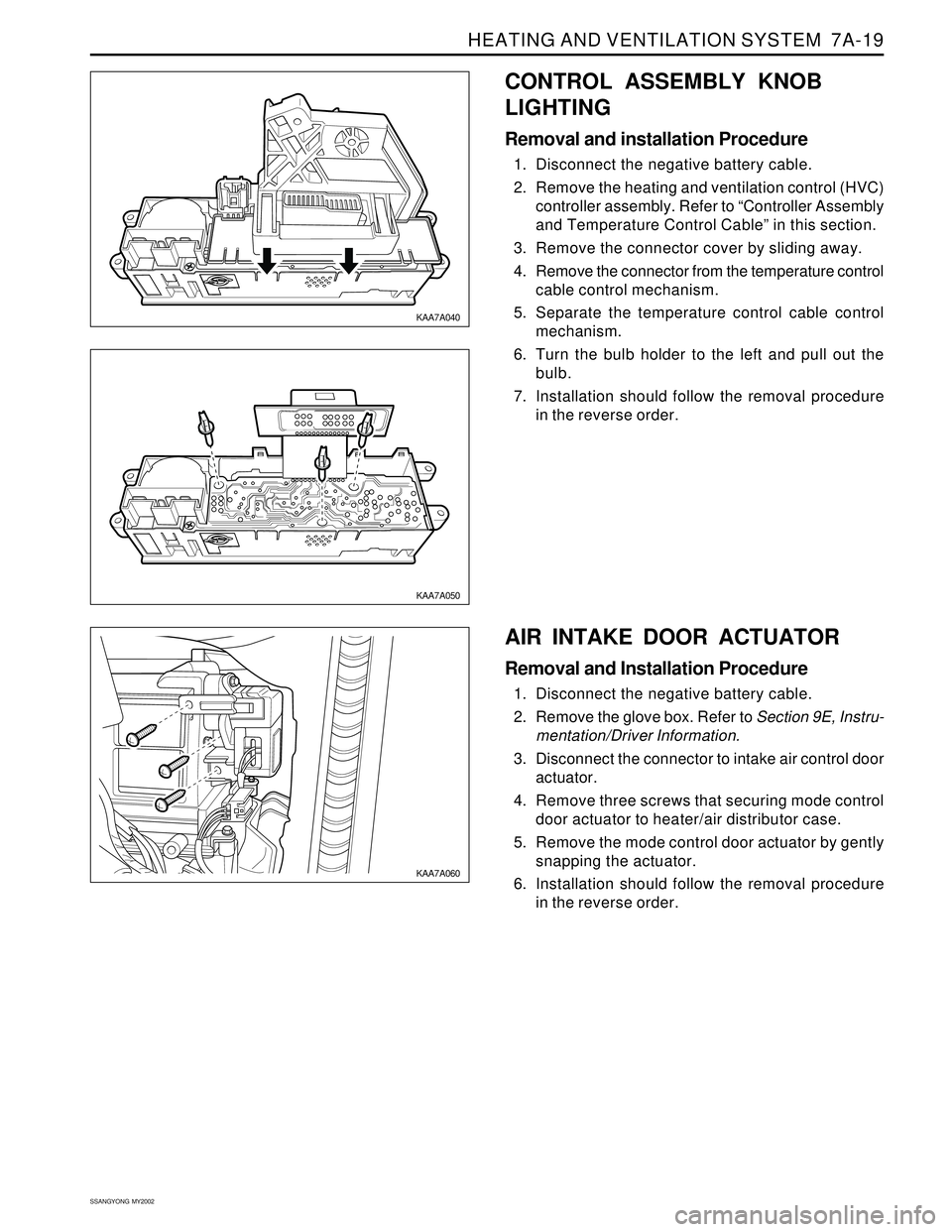
HEATING AND VENTILATION SYSTEM 7A-19
SSANGYONG MY2002
CONTROL ASSEMBLY KNOB
LIGHTING
Removal and installation Procedure
1. Disconnect the negative battery cable.
2. Remove the heating and ventilation control (HVC)
controller assembly. Refer to “Controller Assembly
and Temperature Control Cable” in this section.
3. Remove the connector cover by sliding away.
4. Remove the connector from the temperature control
cable control mechanism.
5. Separate the temperature control cable control
mechanism.
6. Turn the bulb holder to the left and pull out the
bulb.
7. Installation should follow the removal procedure
in the reverse order.
KAA7A040
KAA7A050
KAA7A060
AIR INTAKE DOOR ACTUATOR
Removal and Installation Procedure
1. Disconnect the negative battery cable.
2. Remove the glove box. Refer to Section 9E, Instru-
mentation/Driver Information.
3. Disconnect the connector to intake air control door
actuator.
4. Remove three screws that securing mode control
door actuator to heater/air distributor case.
5. Remove the mode control door actuator by gently
snapping the actuator.
6. Installation should follow the removal procedure
in the reverse order.
Page 1521 of 2053
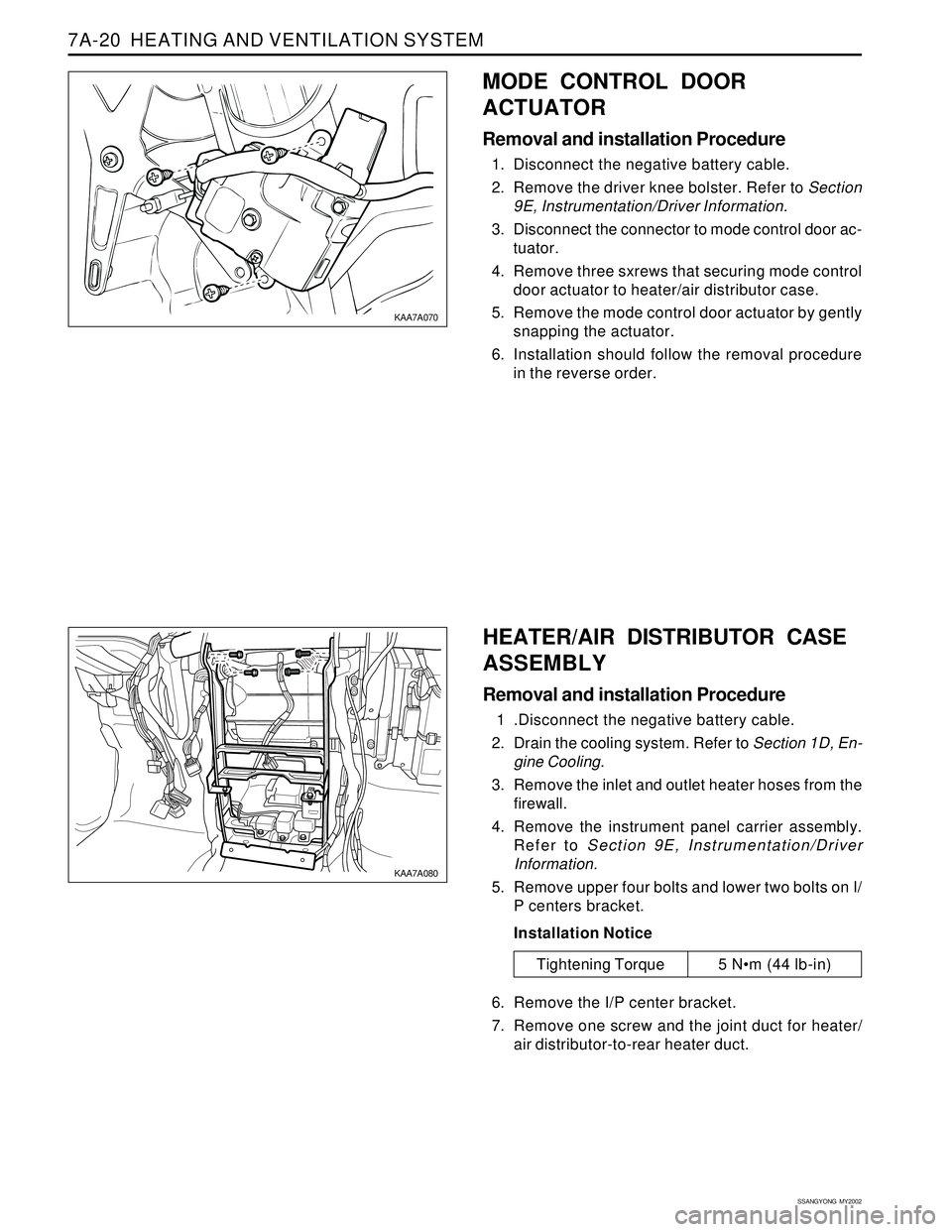
SSANGYONG MY2002
7A-20 HEATING AND VENTILATION SYSTEM
MODE CONTROL DOOR
ACTUATOR
Removal and installation Procedure
1. Disconnect the negative battery cable.
2. Remove the driver knee bolster. Refer to Section
9E, Instrumentation/Driver Information.
3. Disconnect the connector to mode control door ac-
tuator.
4. Remove three sxrews that securing mode control
door actuator to heater/air distributor case.
5. Remove the mode control door actuator by gently
snapping the actuator.
6. Installation should follow the removal procedure
in the reverse order.
Tightening Torque 5 Nm (44 lb-in)
KAA7A070
KAA7A080
HEATER/AIR DISTRIBUTOR CASE
ASSEMBLY
Removal and installation Procedure
1 .Disconnect the negative battery cable.
2. Drain the cooling system. Refer to Section 1D, En-
gine Cooling.
3. Remove the inlet and outlet heater hoses from the
firewall.
4. Remove the instrument panel carrier assembly.
Refer to Section 9E, Instrumentation/Driver
Information.
5. Remove upper four bolts and lower two bolts on I/
P centers bracket.
Installation Notice
6. Remove the I/P center bracket.
7. Remove one screw and the joint duct for heater/
air distributor-to-rear heater duct.
Page 1522 of 2053
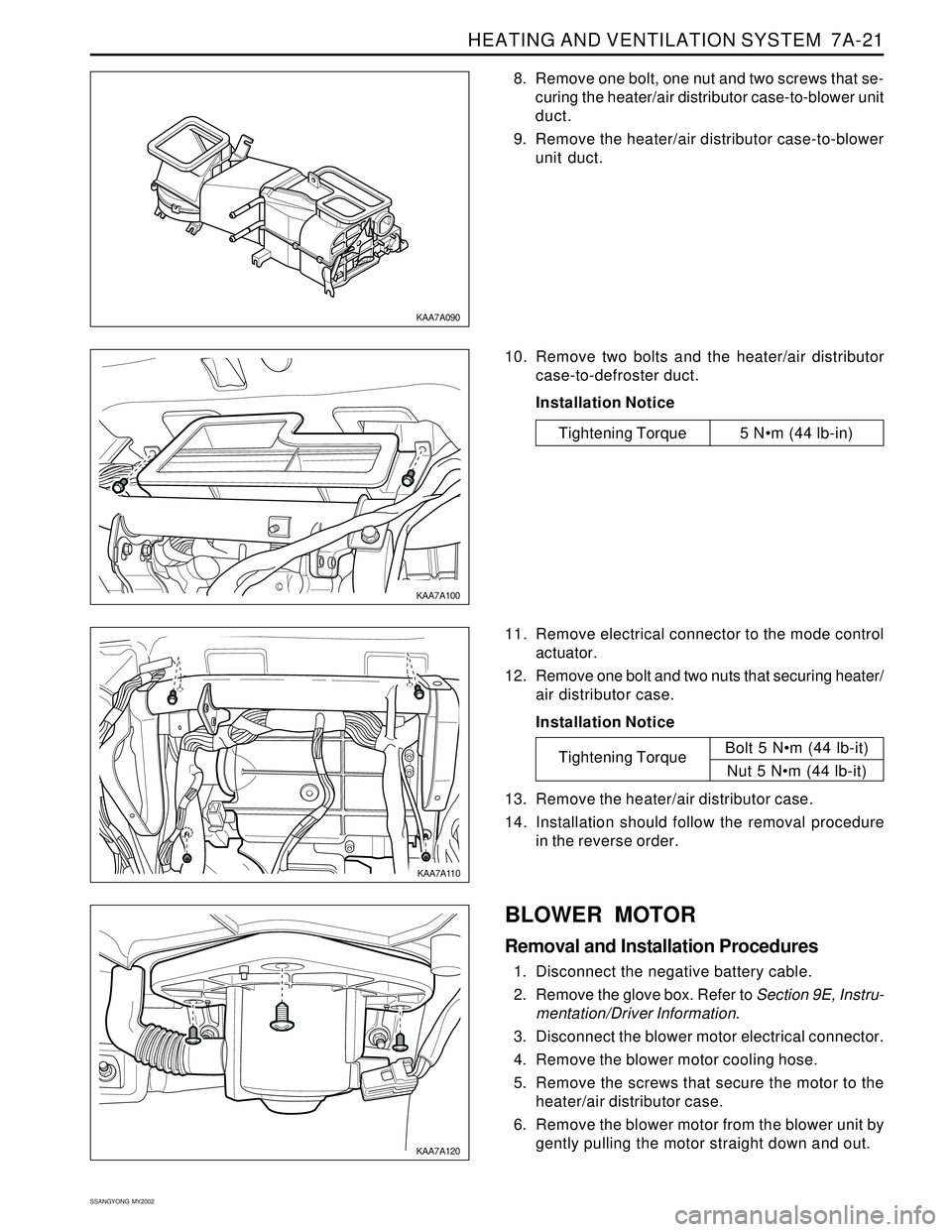
HEATING AND VENTILATION SYSTEM 7A-21
SSANGYONG MY2002
8. Remove one bolt, one nut and two screws that se-
curing the heater/air distributor case-to-blower unit
duct.
9. Remove the heater/air distributor case-to-blower
unit duct.
KAA7A090
KAA7A100
KAA7A110
KAA7A120
10. Remove two bolts and the heater/air distributor
case-to-defroster duct.
Installation Notice
11. Remove electrical connector to the mode control
actuator.
12. Remove one bolt and two nuts that securing heater/
air distributor case.
Installation Notice
13. Remove the heater/air distributor case.
14. Installation should follow the removal procedure
in the reverse order.
Tightening TorqueBolt 5 Nm (44 lb-it)
Nut 5 Nm (44 lb-it)
BLOWER MOTOR
Removal and Installation Procedures
1. Disconnect the negative battery cable.
2. Remove the glove box. Refer to Section 9E, Instru-
mentation/Driver Information.
3. Disconnect the blower motor electrical connector.
4. Remove the blower motor cooling hose.
5. Remove the screws that secure the motor to the
heater/air distributor case.
6. Remove the blower motor from the blower unit by
gently pulling the motor straight down and out.
Tightening Torque 5 Nm (44 lb-in)